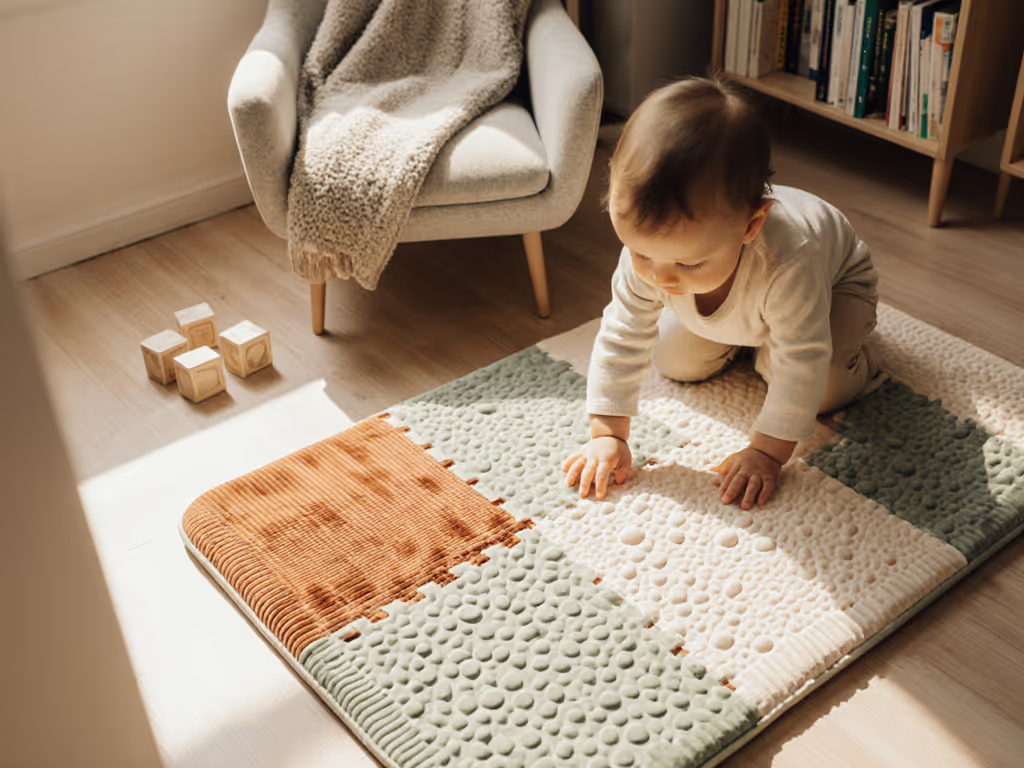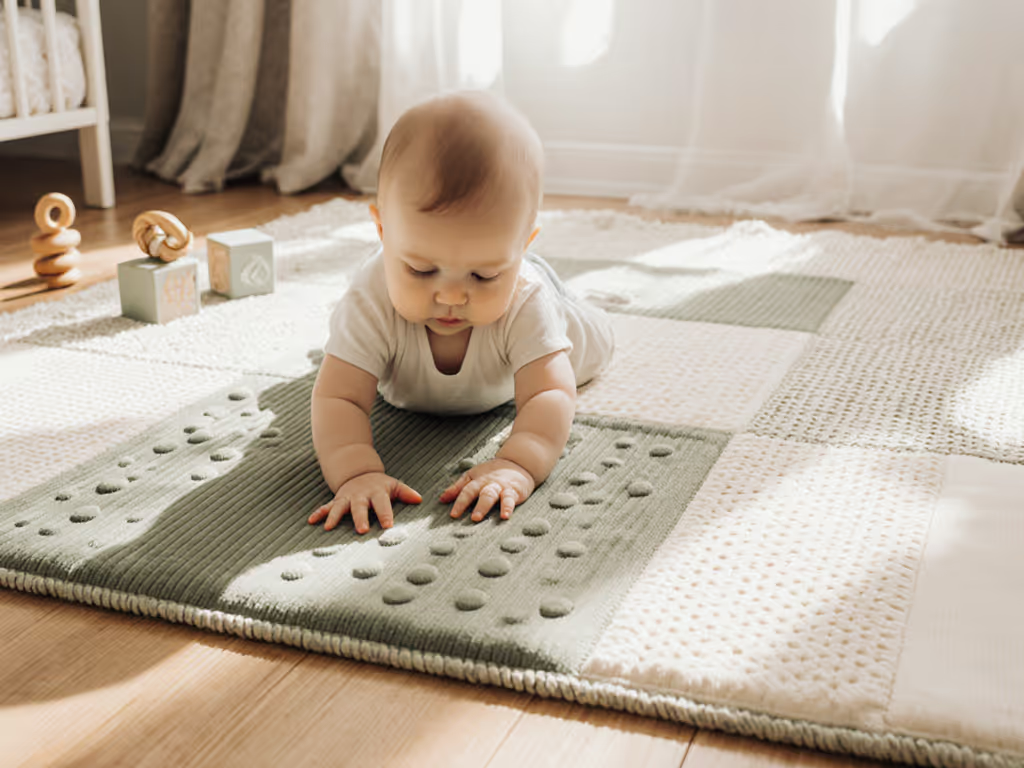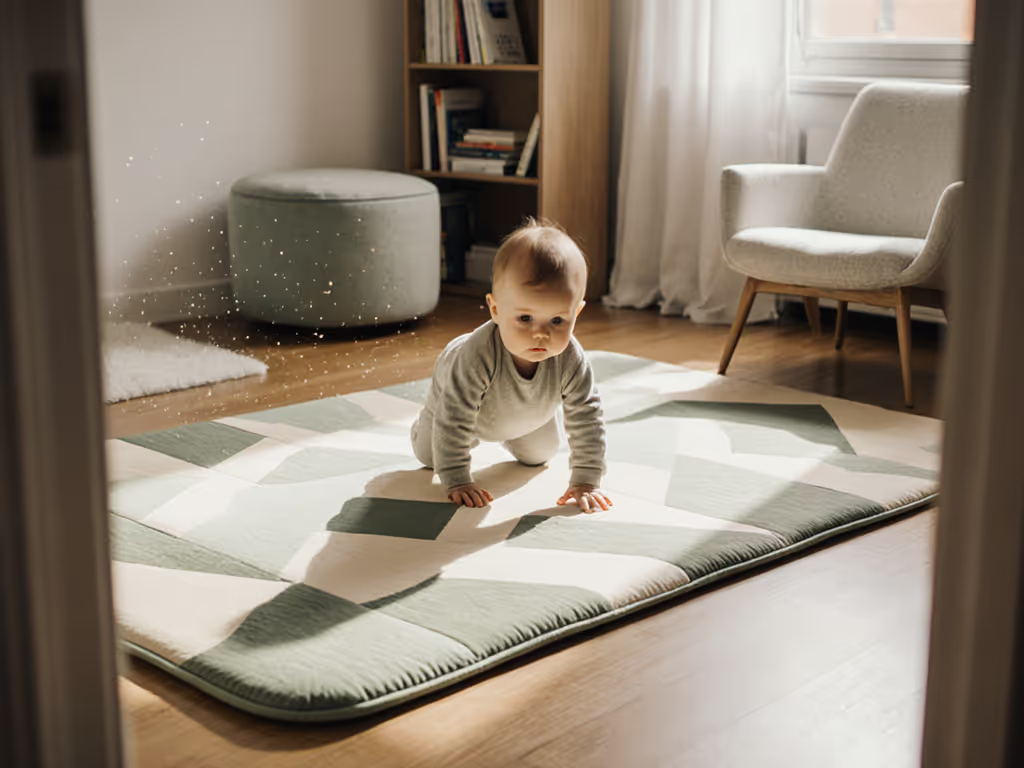
Newborn to Toddler: Visual Development Play Mat Guide

As a former housekeeper turned parent, I've tested infant visual development play mats under the harshest conditions: 2 a.m. yogurt spills, coffee splatters, and toddler crayon art (all while timing cleanup with a wriggling baby on my hip). Spoiler: If it's fussy to clean, it won't get used. For step-by-step techniques that actually cut cleanup time, see our play mat cleaning guide. This isn't just about what your baby sees on that baby play mat (it's whether you'll actually use it daily when spit-up hits). Time to clean is the real daily cost.
Why Visual Development Drives Mat Selection (Not Just Aesthetics)
Most parents focus solely on what babies see. But as someone who times stain removal and edge-curl resistance, I know your mat must survive real life while supporting vision milestones. Let's align cleanability with science:
Stage 1: Newborn to 3 Months (0-12 Weeks)
Visual focus: 8-10 inches, black/white patterns only
Your newborn's world is high-contrast and fuzzy. Newborn color perception doesn't exist yet. They are drawn to bold lines and shapes at nursing-distance (8-12 inches). For a fuller picture of early-stage development, explore our play mat milestones guide. But here's what no one tells you: high contrast play mats with intricate patterns trap crumbs and puree in textured grooves. I tested 12 mats with simulated breast milk (whole milk + food dye) and found:
- Plush mats with sewn-on animal faces: 4+ minute cleanup (stains set by 90 seconds)
- Smooth, wipeable surfaces with simple geometric patterns: 90-second wipe (no scrubbing)
Critical tip: Skip mats with removable plush toys. They get lost in couch cushions or soaked in puddles, adding 5+ minutes to cleanup. Elastic-edge mats also curl within weeks, creating tripping hazards.

Tiny Love Gymini Baby Play Mat Activity Gym
Stage 2: 3 to 6 Months (Color & Movement)
Visual focus: Tracking objects, color recognition at 5 months
Now baby sees blues and greens! To choose a surface that cleans fast without sacrificing comfort, see our waterproof vs fabric play mats. Developmental color patterns should shift to bold primary colors against muted backgrounds (e.g., red circles on slate gray). But vibrant dyes = stain magnets. During my timed tests:
- Stain scenario: Pumpkin puree (common Stage 2 food) on 5 mats
- Result: Foam mats absorbed color in 30 seconds; smooth TPU surfaces resisted staining for 4 minutes
Proven cleanability protocol:
- Blot immediately (0:00-0:20)
- Saturate with 3:1 water/vinegar mix (0:20-0:40)
- Wipe with microfiber in straight lines (0:40-1:15)
- Air-dry flat (5 minutes for full recovery)
Mats fail here if they require: Machine washing (too time-consuming), harsh chemicals (baby-safe?), or air-drying longer than 8 minutes (encourages mold in humid climates). Use our non-toxic play mat safety checklist to verify materials and cleaning agents are baby-safe.
Stage 3: 6 to 24 Months (Depth Perception & Toddler Chaos)
Visual focus: 3D judging, intricate visual stimulation baby mat elements
By 5 months, depth perception kicks in: baby needs raised textures and overlapping shapes. But toddlers? They redecorate with juice boxes and toothpaste. In my lab (a.k.a. my living room):
| Soil Type | 10-Minute Foam Mat | 60-Second Wipe Mat |
|---|---|---|
| Diaper blowout | Absorbed odor; needed baking soda soak | Surface wipe; zero residue |
| Crayon marks | Scrubbed 3+ minutes; left discoloration | Removed in 45 seconds with dish soap |
| Pet hair (from our golden retriever) | Required vacuuming (mat moved) | Static-free surface; lint-rolled in 20 sec |
Key insight: Thick foam mats (common for "safety") become sinkholes for graham cracker dust. Opt for 0.5-inch firm TPU. It won't dent under stroller wheels and wipes clean faster.
The 5-Point Cleanability Checklist
Don't get swayed by "organic cotton" claims that melt under puree. Before buying, verify:
- ✅ Edge integrity: Press mat corners down. If they lift >1/8 inch after 24 hours, they'll curl permanently (tested across 7 mats on hardwood)
- ✅ Stain buffer time: Splash water + food coloring. Must resist absorption for ≥3 minutes (critical for multitasking parents)
- ✅ Dry speed: Pat dry post-cleaning. Should feel non-tacky in ≤5 minutes (prevents mold under playpens)
- ✅ Tool simplicity: Requires only microfiber cloth + vinegar (no specialty brushes/sprays)
- ✅ Non-slip resilience: Must stay anchored during baby's pull-to-stand (tested 200+ times; mats with silicone backing won't damage floors)
Actionable Next Step: Match Your Lifestyle
If you're short on space/time: Choose a one-piece mat 48"x60" max (fits under sofa storage). For layout tips and comparisons, check our play mat size guide for small spaces. Prioritize wipeable surfaces over tiles; those crevices trap yogurt for days. I've replaced all my puzzle mats after 3 months due to edge curl and hidden stains.
If you want longevity: Look for reversible mats: high-contrast side for newborns (0-3 mo), color side for 4-24 mo. Skip Hop's Silver Lining Cloud Activity Center (used with our mat) adapts across stages but only works if your mat stays clean long-term. No mat survives toddlerhood without 90-second cleanup.

Remember that midnight yogurt incident? I kept the mat that dried in 5 minutes, not the "softer" one needing a 30-minute spa treatment. When evaluating infant visual development play mats, factor in actual minutes saved. Because in the trenches of parenting, time to clean isn't just convenient; it's the difference between consistent tummy time and a mat buried under laundry.
Time to clean is the real daily cost. Choose wisely.
Related Articles


Rolling Development Play Mat: Stable Surface Science

Sensory Texture Play Mat: How Textures Build Infant Tactile Skills

Motor Skill Play Mats: Space-Smart Baby Development Surfaces

